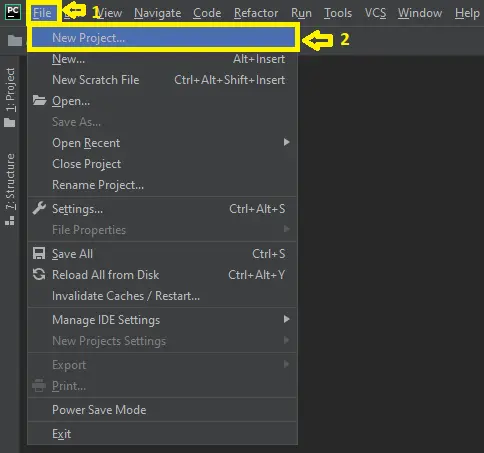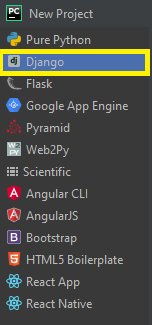Alumni Tracking System in Django with Source Code
This Alumni Tracking System Project in Django created based on python, Django, and MYSQL Database.
The Alumni Tracking System’s flow, university/college alumni will register on the website, and this process will include school management verification in order to enlist the alumnus/alumna as a website user.
A Alumni Tracking System, the admin has verified the user as an alumnus of the school, the alumni user may begin to explore the system’s functionality or functionalities on their own, such as work openings posted by other alumni or admin, a calendar of upcoming events, and joining the alumni connect chat.
To start creating a Alumni Tracking System Project in Python Django, makes sure that you have PyCharm Professional IDE Installed in your computer.
This Alumni Tracking System in Django Framework, Also includes a Download Source Code for free, just find the downloadable source code below and click download now.
| About Project | Project Details | Definition |
|---|---|---|
| Project Name | Alumni Tracking System in Django | The Alumni Tracking System in Django is an easy project for beginners to learn how to build a web-based python Django project. We will provide you with the complete source code and database for the python project so that you can easily install it on your machine and learn how to program in Python Django. |
| Python version (Recommended) | 3.8 Version | Python 3.8 introduces some new syntax to the language, as well as a few small modifications to existing behavior and, most importantly, a slew of performance improvements, following in the footsteps of the previous 3.7 version. |
| Programming Language Used | Python Django Language | Django is a high-level Python web framework for building safe and maintainable websites quickly. Django is a web framework built by experienced developers that takes care of a lot of the heavy lifting so you can focus on developing your app instead of reinventing the wheel. |
| Developer Name | itsourcecode.com | Free projects containing source code in Java, PHP, Python, Django, VB.Net, Visual Basic, C, C++, C#, Javascript, and other languages are available on this website. |
| IDE Tool (Recommended) | Sublime, Visual Studio, PyCharm | Sublime Text is a source code editor that is available for purchase. It comes with built-in support for a variety of programming and markup languages. Plugins, which are often community-built and maintained under free-software licenses, allow users to extend the functionality of the system. Sublime Text has a Python API to help with plugins. |
| Project Type | Web Application | A web application, unlike computer-based software programs that operate locally on the device’s operating system, is application software that runs on a web server. The user uses a web browser with an active network connection to access web apps. |
| Database | SQLite | SQLite is a programming language that is used to create embedded software for devices such as televisions, cell phones, and cameras. It can handle HTTP requests with low to medium traffic. SQLite has the ability to compress files into smaller bundles with less metadata. SQLite is a temporary dataset that is used within an application to process data. |
Student Features of Alumni Tracking System in Django
- Login Page – Student enter their website credentials on this page to gain access to all of the website’s features.
- Register Page – The page where new Student created their login credentials for the website.
- Home Page– When Student visit the website, this is the system’s default page. This page shows the home, current event, colleges, alumni, alumni connect chat and profile.
- Manage Profile Page – This is the page where the student can update their profile.
- View Current Event – This is the page where the student can view current event posted by admin.
- View Colleges – This is the page where the student can view school college.
Alumni Tracking System in Django Steps on How to Create a Project
Time needed: 5 minutes
Here are the steps on how to create a Alumni Tracking System in Django with Source Code.
- Step 1: Open file.
First , open “pycharm professional” after that click “file” and click “new project”.

- Step 2: Choose Django.
Next, after click “new project“, choose “Django” and click.

- Step 3: Select file location.
Then, select a file location wherever you want.

- Step 4: Create application name.
After that, name your application.

- Step 5: Click create.
Lastly, finish creating project by clicking “create” button.

- Step 6: Start Coding.
Finally, we will now start adding functionality to our Django Framework by adding some functional codes.
Functionality and Codes of the Alumni Tracking System in Django
- Create template for the homepage in Alumni Tracking System Project in Django.
In this section, we will learn on how create a templates for the homepage. To start with, add the following code in your base.html under the folder of /templates/.
{% load static %}
<!DOCTYPE html>
<html lang="en">
<head>
<meta charset="utf-8">
<title>Alumni Tracker</title>
<meta content="width=device-width, initial-scale=1.0" name="viewport">
<meta content="" name="keywords">
<meta content="" name="description">
<link rel="stylesheet" href="https://stackpath.bootstrapcdn.com/bootstrap/4.4.1/css/bootstrap.min.css" integrity="sha384-Vkoo8x4CGsO3+Hhxv8T/Q5PaXtkKtu6ug5TOeNV6gBiFeWPGFN9MuhOf23Q9Ifjh" crossorigin="anonymous">
<meta charset="utf-8">
<meta name="viewport" content="width=device-width, initial-scale=1, shrink-to-fit=no">
<link href="{% static 'base/img/title.jpg'%} " rel="icon">
<link href="{% static 'base/img/title.jpg' %}" rel="apple-touch-icon">
<link href="https://fonts.googleapis.com/css?family=Open+Sans:300,300i,400,400i,700,700i|Montserrat:300,400,500,700" rel="stylesheet">
<link href="//maxcdn.bootstrapcdn.com/font-awesome/4.3.0/css/font-awesome.min.css" rel="stylesheet">
<link rel="stylesheet" href="https://maxcdn.bootstrapcdn.com/bootstrap/4.4.1/css/bootstrap.min.css">
<link href="{%static 'base/lib/bootstrap/css/bootstrap.min.css'%}" rel="stylesheet">
<link href="{% static 'base/lib/font-awesome/css/font-awesome.min.css' %}" rel="stylesheet">
<link href="{% static 'base/lib/animate/animate.min.css'%}" rel="stylesheet">
<link href="{% static 'base/lib/ionicons/css/ionicons.min.css' %}" rel="stylesheet">
<link href="{% static 'base/lib/owlcarousel/assets/owl.carousel.min.css'%}" rel="stylesheet">
<link href="{% static 'base/css/style.css'%}" rel="stylesheet">
<link href="{% static 'base/header/css/style.css' %}" rel="stylesheet" type="text/css" />
<link href="https://fonts.googleapis.com/css?family=Poppins:300,400,500,600,700" rel="stylesheet">
<link href="https://fonts.googleapis.com/css?family=Lora:400,400i,700,700i&display=swap" rel="stylesheet">
<link href="https://fonts.googleapis.com/css?family=Abril+Fatface&display=swap" rel="stylesheet">
</head>
<body>
<header class="header-section" style="margin-bottom: 76px">
<nav class="navbar navbar-expand-md navbar-dark bg-primary site-navbar fixed-top">
<a class="navbar-brand site-logo" href="{% url 'home' %}">
<h2><span class="text-light">Alumni</span> Tracker System</h2>
</a>
<button class="navbar-toggler d-lg-none" type="button" data-toggle="collapse" data-target="#collapsibleNavId" aria-controls="collapsibleNavId" aria-expanded="false" aria-label="Toggle navigation">
<span class="navbar-toggler-icon"></span>
</button>
<div class="collapse navbar-collapse" id="collapsibleNavId">
<ul class="navbar-nav ml-auto mt-2 mt-lg-0">
<li class="nav-item">
<a class="nav-link" href="{% url 'home' %}">Home <span class="sr-only">(current)</span></a>
</li>
<li class="nav-item">
<a class="nav-link" href="#">Current Events</a>
</li>
<li class="nav-item">
<a class="nav-link" href="{% url 'show-college' %}">Colleges</a>
</li>
<li class="nav-item">
<a class="nav-link" href="{% url 'show-alumni' %}">Alumni</a>
</li>
{% if request.user.is_authenticated %}
<li class="nav-item">
<a class="nav-link" href="{% url 'logout' %}">Logout</a>
</li>
<li class="nav-item">
<a class="nav-link" href="#">Alumni Connect Chat</a>
</li>
{%if not request.user.is_college %}
<li class="nav-item">
<a class="nav-link" href="{% url 'alumni-profile' request.user.id%}">Profile</a>
</li>
{%elif request.user.is_college %}
<li class="nav-item">
<a class="nav-link" href="{% url 'pending-query' %}">Pending Queries</a>
</li>
<li class="nav-item">
<a class="nav-link" href="{% url 'college-profile' request.user.id %}">Profile</a>
</li>
{%endif%}
{% else %}
<li class="nav-item">
<a class="nav-link" href="{% url 'login' %}">Login</a>
</li>
<li class="nav-item">
<a class="nav-link" href="{% url 'alumni_signup' %}">Alumni-Signup</a>
</li>
{% endif %}
{% if request.user.is_authenticated and request.user.is_superuser %}
<li class="nav-item">
<a class="nav-link" href="{% url 'college_signup' %}">College-Signup</a>
</li>
{% endif %}
</ul>
</div>
</nav>
</header>
{% block content %}
{% endblock %}
<footer id="footer">
<div class="container">
<div class="copyright">
© Copyright <strong>Alumin Tracking System 2021</strong>. All Rights Reserved
</div>
</div>
</footer>
<script src="{%static 'base/header/js/jquery-3.2.1.min.js' %}"></script>
<script src="{%static 'base/header/js/bootstrap.min.js' %}"></script>
<script src="{%static 'base/header/js/owl.carousel.min.js' %}"></script>
<script src="{%static 'base/header/js/main.js' %}"></script>
<script type="text/javascript" src="https://cdnjs.cloudflare.com/ajax/libs/jquery/2.1.3/jquery.min.js"></script>
<script src="https://ajax.googleapis.com/ajax/libs/jquery/3.4.1/jquery.min.js"></script>
<script src="https://cdnjs.cloudflare.com/ajax/libs/popper.js/1.16.0/umd/popper.min.js"></script>
<script src="https://maxcdn.bootstrapcdn.com/bootstrap/4.4.1/js/bootstrap.min.js"></script>
</body>
</html>- Create template for the view college in Alumni Tracking System Project in Django.
In this section, we will learn on how create a templates for the view college. To start with, add the following code in your showcollege.html under the folder of /templates/.
{% extends "base.html" %} {%load static%} {% load crispy_forms_tags %} {% load templatetags %} {% block content %}
<br>
<div class="container-fluid"><br>
<div class="row">
<div class="col-sm-7" >
{% for p in page_obj %}
<hr>
<a href="{% url 'college-detail' p.id %}" style="color: black">
<div class="mx-auto ">
<div class="row">
<div class="avatar mx-auto white col-sm-5">
<img src="{{ p.Image.url }}" style="height: 150px;width: 200px" class="rounded mx-auto d-block">
</div>
<div class="col-sm-6 ">
<h4 class="card-title text-danger">{{p.College}}</h4>
<hr>
<p class="text-info">{{p.About}}</p>
</div>
</div>
</div>
</a>
{%endfor%}
<div class="pagination" style="margin-left: 100px;margin-top: 50px">
<span>
{% if page_obj.has_previous %}
<a class="btn btn-outline-info" href="?{% query_transform request page=1 %}">« first</a>
<a class="btn btn-outline-info" href="?{% query_transform request page=page_obj.previous_page_number %}">previous</a>
{% endif %}
<a class="cbtn btn-outline-info disabled">
Page {{ page_obj.number }} of {{ page_obj.paginator.num_pages }}
</a>
{% if page_obj.has_next %}
<a class="btn btn-outline-info" href="?{% query_transform request page=page_obj.next_page_number %}">next</a>
<a class="btn btn-outline-info" href="?{% query_transform request page=page_obj.paginator.num_pages %}">last »</a>
{% endif %}
</span>
</div>
</div>
</div>
<br>
</div>
<br>
<br>
<br>
<br>
<br>
<br>
{%endblock%}- Create template for the login page in Alumni Tracking System Project in Django.
In this section, we will learn on how create a templates for the login page. To start with, add the following code in your login.html under the folder of /templates/registration.
{% extends 'base.html' %}
{% load i18n %}
{% load crispy_forms_tags %}
{% block content %}
<br>
<div class="mx-auto bg-warning" style="width:600px">
<div class="card text-center border border-light p-2">
<div class="col-md-10 col-sm-10 col-12">
<h5 class="card-header info-color white-text text-center py-4">
<strong>Log In</strong>
</h5>
<div class="md-forms" >
<form class="border border-light p-5" method="post" novalidate>
{% csrf_token %}
<input type="hidden" name="next" value="{{ next }}">
{{ form|crispy }}
<button class="btn btn-info btn-block my-4" type="submit">Login</button>
</form>
</div>
</div>
</div>
</div>
<br>
<br>
<br>
<br>
<br>
<br>
<br>
<br>
<br>
<br>
{% endblock %}Downloadable Source Code Below.
Anyway, if you want to level up your programming knowledge, especially python, try this new article I’ve made for you Best Python Projects with source code for Beginners.
But If you’re going to focus on web development using Django, you can download here from our list of Best Django Projects with source code based on real-world projects.
How To Run The Alumni Tracking System in Django?
- Step 1: Extract/unzip the file
- Step 2: Go inside the project folder, open cmd and type the following commands to install Django Framework and run the webserver:
- pip install -r requirements.txt
- python manage.py migrate
- python manage.py runserver
- Step 3: Finally, open the browser and go to http://127.0.0.1:8000/
Summary
In summary, this Alumni Tracking System in Django with Source Code can be useful to students or professional who wants to learn python programming language.
This project can also be modified to fit your personal requirements. Hope this project will help you to improve your skills. Happy Coding!
- How To Make A Point Of Sale System In Python
- Best Python Projects for Beginners
- Python MySQL Connection: Simple Python Step by Step Guide
- Python PIP Command Set-up / Fix: Step by Step Guide
- Random Password Generator in Python Projects With Source Code
- Python Range Function|Range in Python Explained with Examples
- School Management System Project In Django With Source Code
- Django Login And Registration With Source Code
- CRUD App In Django With Source Code
- Drag And Drop JavaScript With Source Code
- Todo List App Django With Source Code
Inquiries
If you have any questions or suggestions about Alumni Tracking System in Django with Source Code, please feel free to leave a comment below.



is it possible po ba na Visual Basic and Language na gamitin instead of Python?